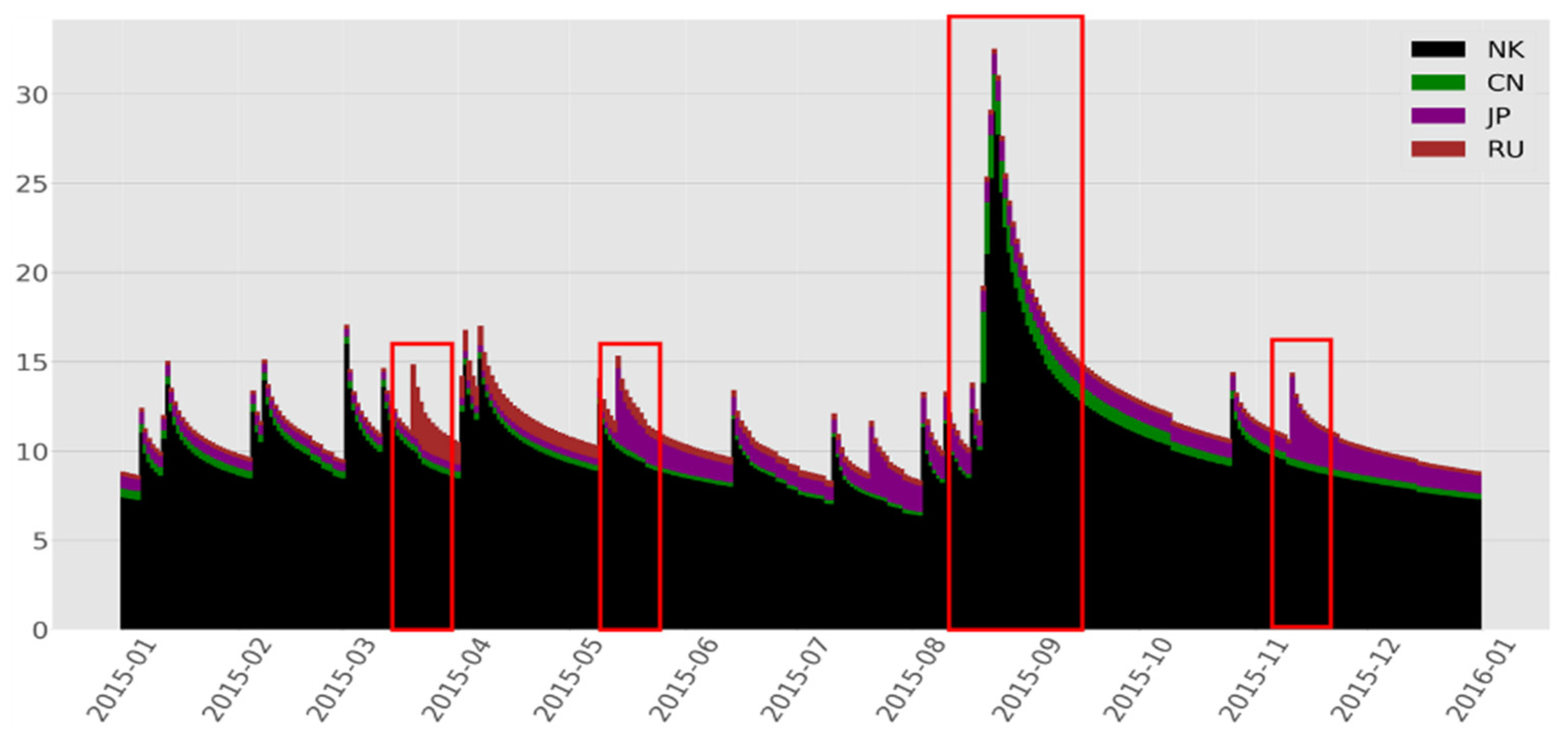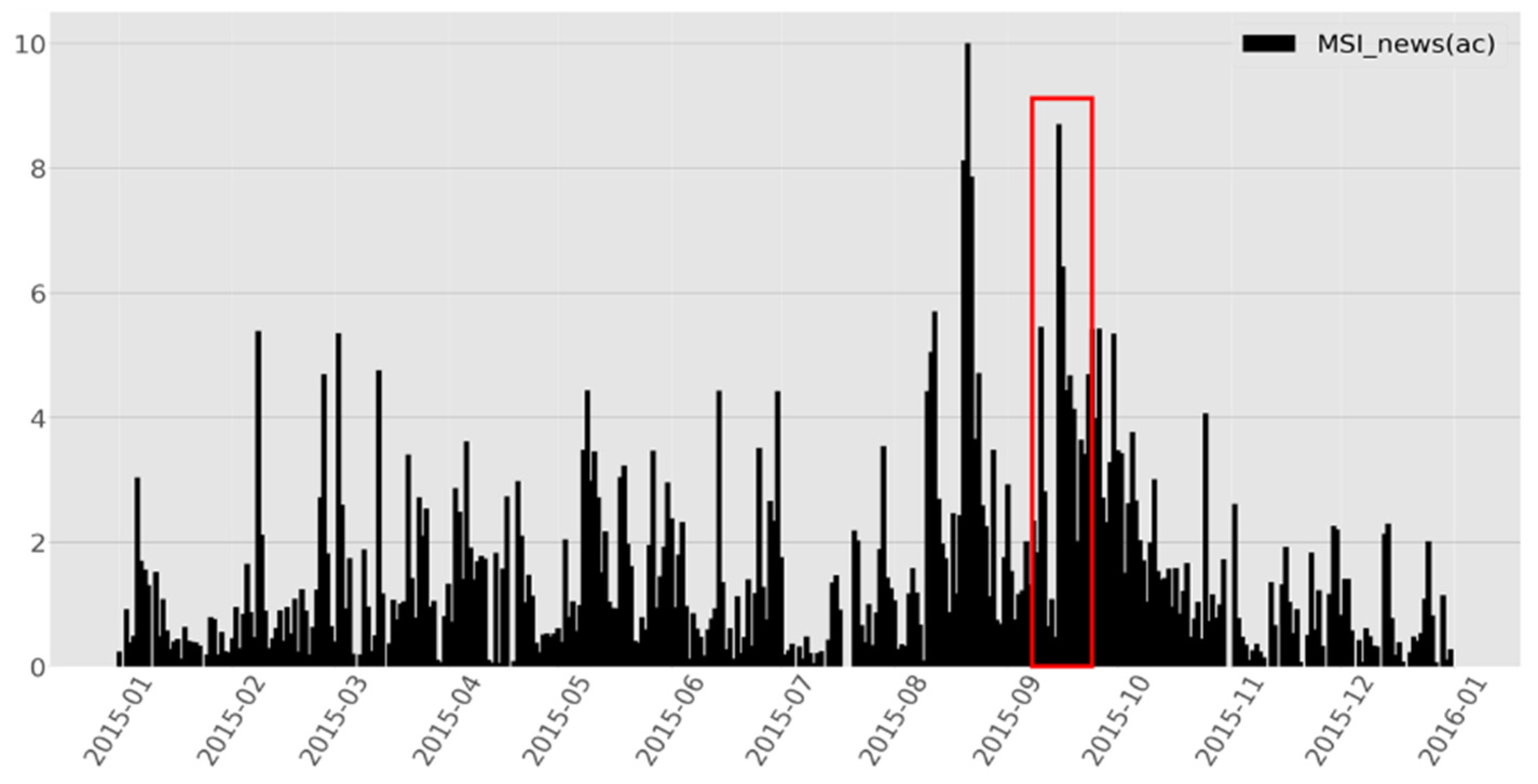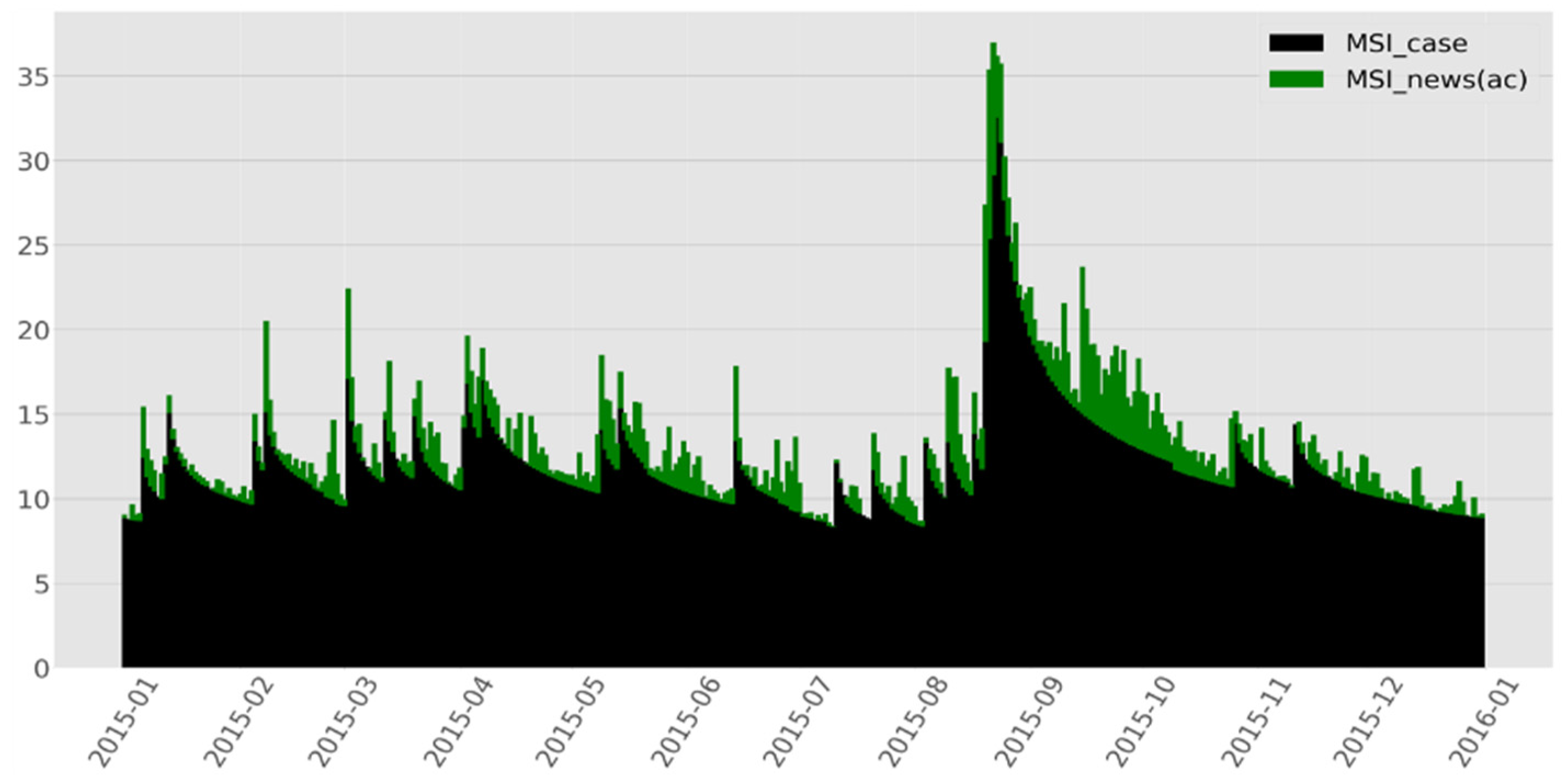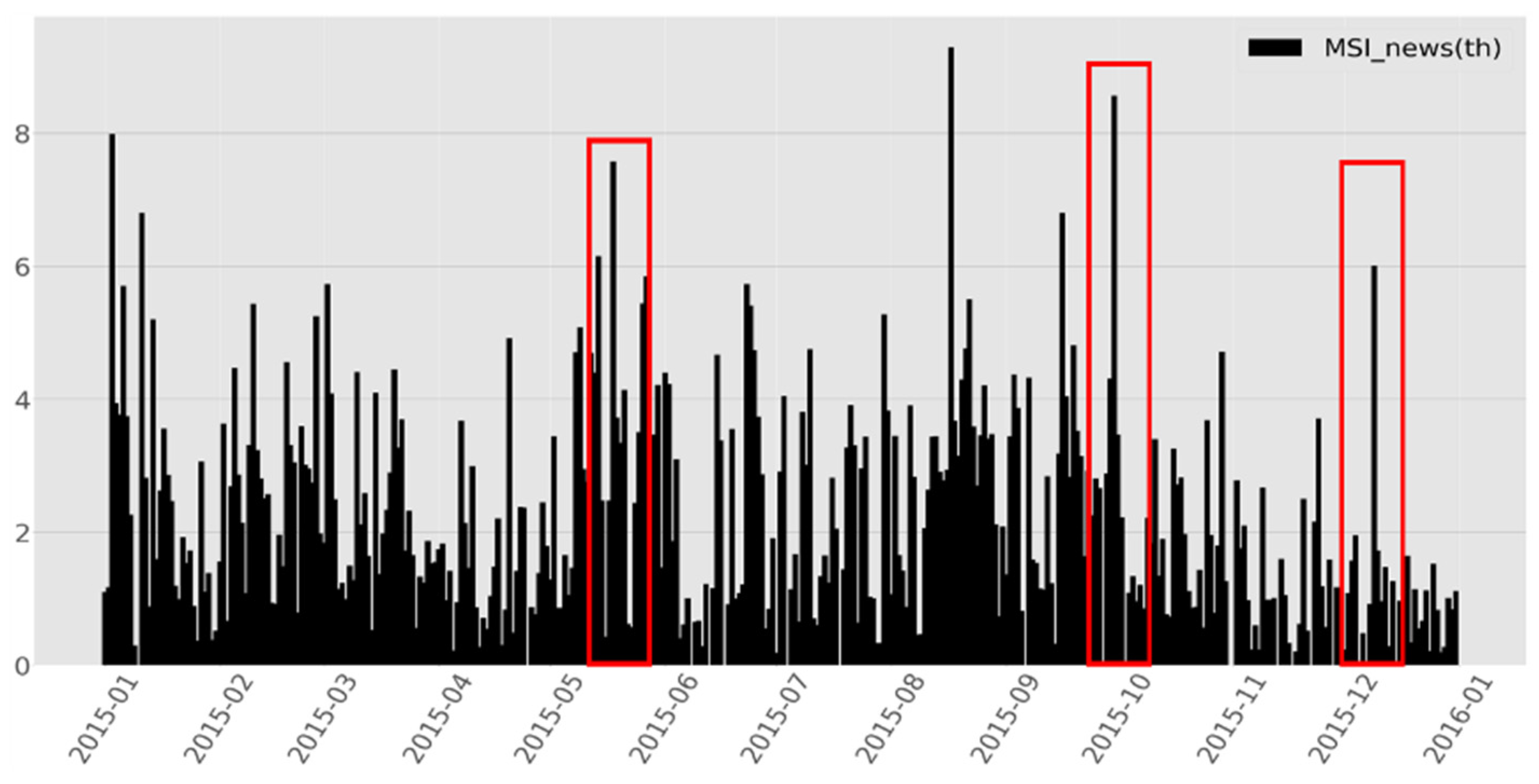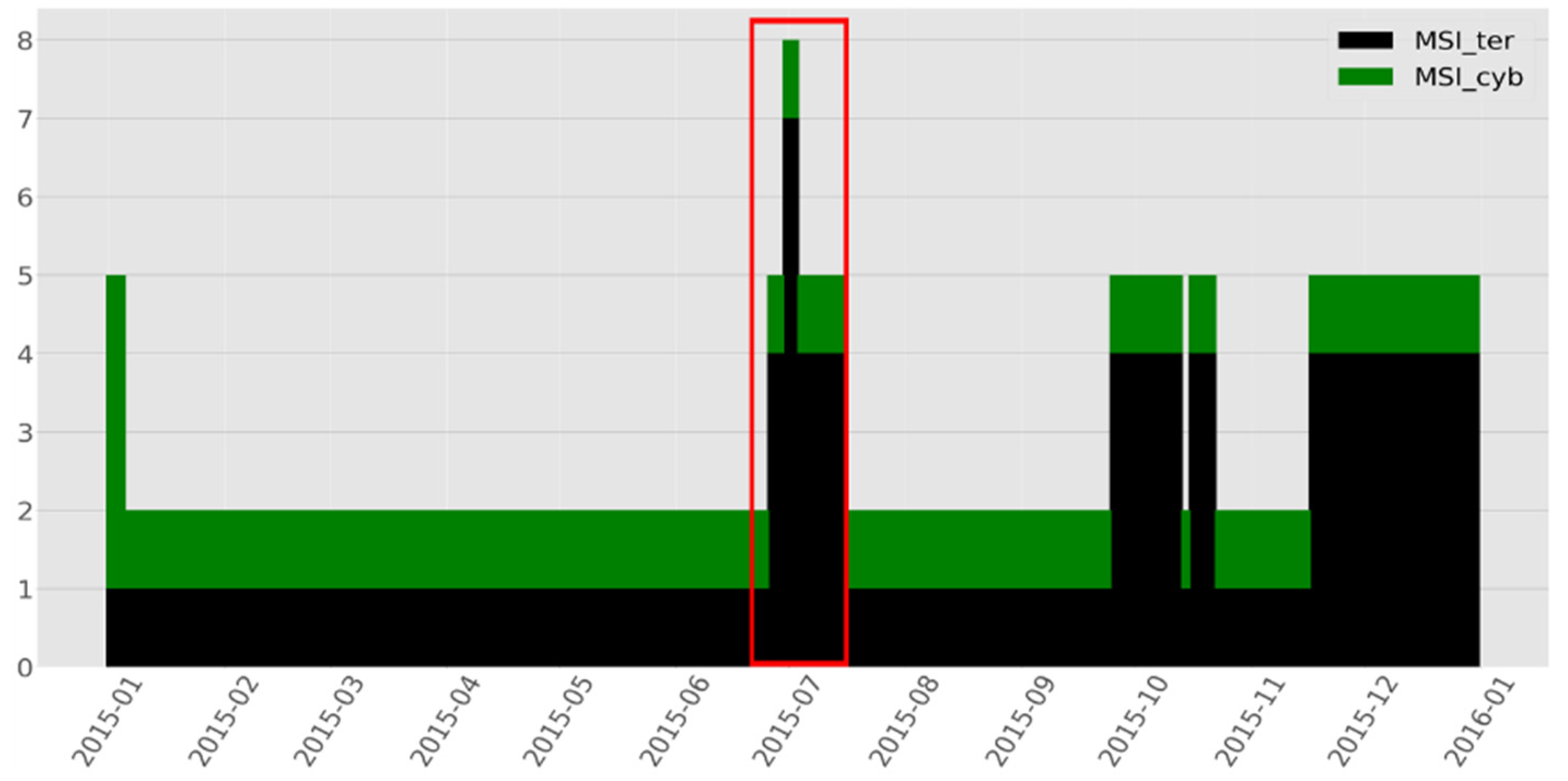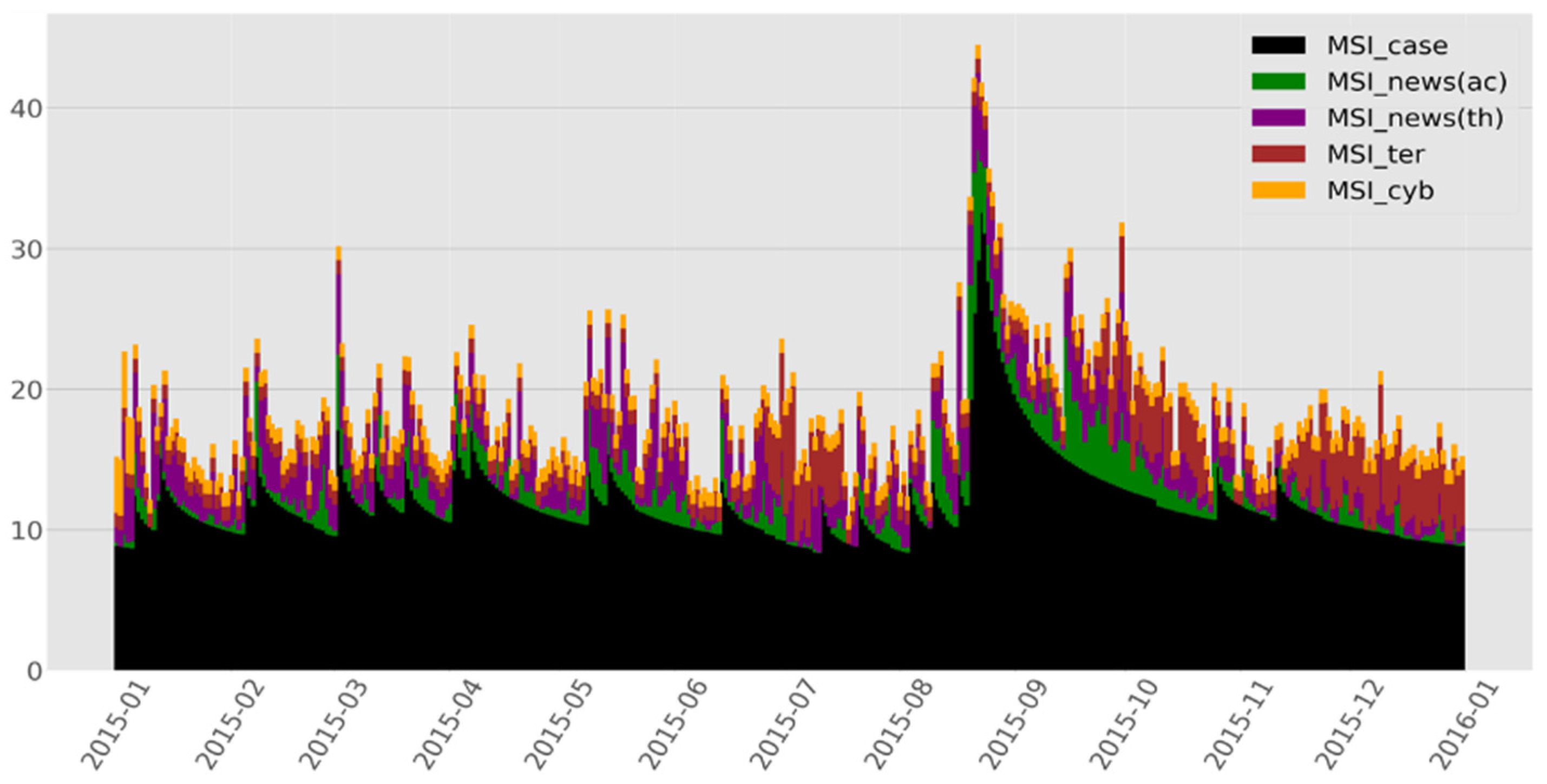1. Introduction
Recently, the security situation on the Korean Peninsula has changed more rapidly than ever. There are various factors behind this change, including the New Cold War caused by the US–China hegemony struggle. After the end of the US–Soviet Cold War, countries around the world enjoyed a long period of peace, including active trade and exchange as part of the global network. However, China’s economic rise and the challenge of US hegemony under Xi Jinping have led to new confrontations, starting with the US–China trade war. In addition, Russia’s armed invasion of Ukraine has caused significant global divisions. This change can be more clearly seen in the announcement of the new strategic 12-year plan adopted by NATO, the Western world’s leading military organization, at the 2022 Madrid Summit. In this announcement, NATO defined China and Russia as direct security threats, in contrast to their characterization of China and Russia as cooperative partners in the previous announcement (
NATO 2022). The new Cold War structure between Russia, China, and Western forces heralds a major change in military and foreign policy on the Korean Peninsula.
Amid this New Cold War, rapid changes in the security landscape of Northeast Asia, which is considered a flash point, have also been observed.
The inter-Korean conflict has continued into 2022, involving a series of provocations and the possibility of a seventh nuclear test. The Yoon Suk-yeol administration (2022~), which is determined to strongly counter North Korea’s provocations, is planning to impose sanctions on the North by forming diplomatic and security ties with hardliners who led strong policies against the North during the Lee Myung-Bak administration (2008~2013). Meanwhile, the Biden administration is also expected to put strong pressure on the new US ambassador to South Korea, classified as a hardliner on North Korea, with the nickname, “The Grim Reaper of North Korea,” which is likely to worsen inter-Korean relations.
Korea–China relations indicate that the US–China tightrope diplomacy of the Moon Jae-In administration (2017~2022) is leaning toward the US due to the emergence of the Yoon Seok-yeol administration and the New-Cold-War situation. This can be seen from the new government’s willingness to rebuild the Korea–US alliance and strengthen the comprehensive strategic alliance and its policy stance to set the Korea–US alliance as a focus on foreign and security policies amid US–China competition. In addition, China criticized the president’s attendance at the NATO summit, saying it would “damage the diplomatic independence of Asia and worsen relations with China.” (
Hankyung 2022). In addition, the recent rapid increase in anti-Chinese sentiment in Korea over issues, such as the Terminal High Altitude Area Defense (THAAD) retaliation, COVID-19 and fine dust, the Northeast Project and history recognition, and the Hanbok and Kimchi controversy, is believed to show another possibility of worsening relations (
Chung 2022).
Uncertainty is growing around not only relations with China but also future relations between Korea and Russia. After Russia’s armed invasion of Ukraine, the Korean government is participating in economic and financial sanctions against Russia in participation with the international community, such as the US and Europe, and is providing military supplies for non-lethal purposes to Ukraine. Accordingly, Russia designated and criticized Korea as an unfriendly country, and threatened it by daily invading the Korea Air Defense Identification Zone (KADIZ) through military aircraft. According to the Russian International Affairs Council (RIAC), a Russian think tank, there are even strong opinions about dismantling the 15-year strategic partnership between South Korea and Russia, reviving military-technology aid, or building a Russian military base in North Korea (
RIAC 2022).
The Yoon Suk-yeol administration hopes to see a turning point in improving Korea–Japan relations based on a military and diplomatic consensus about North Korea’s nuclear weapons and the need to address China through military and security cooperation between South Korea, the US, and Japan. Meanwhile, Japan has begun to recover its past momentum with a common nationalization movement represented by the Self-Defense Forces (SDF)’s rearmament, which is actively supported by the US under the pretext of checking China. Furthermore, Abe’s assassination sparked a wave of condolences for the Japanese people, with support for the Liberal Democratic Party and a return of far-right politics reflected in the upper-house election, leading conservative parties to win more seats. Despite the atmosphere of improving relations between Korea and Japan, the rise of Japan’s far-right forces and the rearmament of the SDF may spark a new security threat.
If the South Korea–US alliance, the additional deployment of the THAAD, the joining of the Quadrilateral Security Dialogue (Quad), and the three-party security cooperation are embodied by the Yoon Suk-yeol administration as a presidential pledge, the situation in the region may result in a solid confrontation between Korea, the United States, and Japan and North Korea, China, and Russia, further heightening the security crisis in Northeast Asia (
Yoon 2022).
The recent rapid change in the security situation in Northeast Asia increases the need for timely and objective evaluation of geopolitical crisis.
Due to the security realities of the Republic of Korea, the world’s only divided and truce nation, many attempts have been made in the past to index the geopolitical crisis of the Korean peninsula as a concept of peace index. On the other hand, in judging the crisis, the majority of cases dealt only with inter-Korean relations. Due to the limitations of qualitative measurement, such as collection through people, expert questionnaires, and evaluations, it is limited to quarterly, semi-annual, and annual publications. There is a limit that it does not reflect the cyber security and the risk of terrorism from home and abroad. In particular, in terms of timeliness, the general public does not have a security index that can directly experience the degree of geopolitical crisis, except for the security crisis that is encountered through news articles. This raises the need to develop quantitative indicators that can measure not only the situations in North Korea but also those in China, Japan, and Russia, in relation to timely and new threats.
The development of measurement indicators satisfying these conditions can be an alternative to addressing the public’s anxiety about the foreign-security situation and can also be used as an auxiliary indicator in the commander’s decision on military policy formulation and security issues. In particular, it is expected that it will contribute to the elimination of national-security insensitivity that has become accustomed to the long-standing confrontation with North Korea.
In this study, first of all, the scope of military-security measurement is set and the results are derived based on the data obtained through military data and newspapers that can be used for the most objective and rapid measurement of the set range. Based on the quantitative results analyzed in a time series through statistical analysis techniques, such as scientific methodology in international relations research, the effectiveness was discussed and explained through a comparison with the cases of military-security conflicts on the Korean peninsula. In this process, the values constituting the index are divided into provocative acts, threats, and other threats, and they are combined to complement the shortcomings of each component. The study focuses on solving a range of quantitative, timely, and measurement problems mentioned above.
2. Scope and Method of Research
2.1. Range of Military Security Measurement
In the narrow sense of geopolitics, geographical characteristics are defined by academics regarding the relationship between countries and the struggle for world domination (
Foster 2006). The term geopolitics, universally used, is used to encompass political factors as well as geographical characteristics in a broader sense. In this study, geopolitical risks are defined as threats, practical actions, and side effects that can affect international relations from a military perspective, such as war and terrorism.
With the development of geopolitical study, quantification for evaluating and predicting geopolitical risks in countries or specific areas has been studied for a long time and has been developed for various purposes. For example, the financial industry can be selected in areas that are most sensitive to geopolitical risks. The geopolitical crisis in the financial industry is a factor that has a great impact on the movement of the stock market and the direction of investment in real time. Since it is directly related to investment revenue, entrepreneurs, market participants, banks, and securities, companies have continued their efforts to measure and predict the economic effects of a security crisis. Meanwhile, attempts to measure security in academic or military aspects have also been steadily developed. This study aimed to measure geopolitical risks in military aspects, focusing on academic purposes, and it was judged that it is possible to express them by measuring the relevant sectors through the definition of military security.
Military-security concerns government policies that can protect the state from domestic and international military threats, usually focusing on protection from external rather than internal threats (
Fry 2010). This can be seen primarily in two aspects: first, it is related to military power, which is the military attack and defense ability of the country and other countries; the other is related to the threat of the other country and its intention (
Szpyra 2014).
On the other hand, today’s security environment is very complex, and unlike the aspects of war in the past, there is a hybrid threat that breaks down the boundaries of traditional non-traditional conflicts. Future military-security threats will be characterized by the combination of traditional and irregular tactics, the dispersion of war planning and execution, and the innovative use of war technology by non-state actors (
Hoffman 2009). In other words, today’s war is a war in which “the lethality of state conflict with the fanatical and protracted fervor of irregular warfare” and “wars … in which Microsoft coexists with machetes and stealth technology is met by suicide bombers.” (
Gates 2009). Therefore, in order to measure military security, evaluation of hybrid threats, such as terrorism and cyber security, must be done in parallel.
For the quantification of military security according to the definition of military security, it will be possible to consider the degree of maintenance of military balance considering the geopolitical position in relation to the aspect of military power, measurement of external threats, and internal confusion.
The comparison of military power to represent military balance is excluded from this study based on real-time measurement because real-time evaluation and immediate feedback are limited in reality, and the survey was mainly focused on the method of calculating internal and external threats.
2.2. A Study on the Peace Index of Korean Peninsula
The most common way of indexing peace is to set up the concept of the upper area that constitutes the peaceful degree of the individual country, determine the indicator that can reflect it, and synthesize it. Examples include the Inter-Korean Integration Index, the Korean Peninsula Security Index, and the HRI Korean Peninsula Peace Index (
Lee 2008).
The Inter-Korean Integration Index (IKII), published annually by the Seoul National University Institute for Peace and Unification Studies, is an evaluation and index of the degree of inter-Korean integration in economic, political, and social culture. The result value is measured based on objective indicators, such as statistics, structural relationships, and system construction stages, and subjective indicators, such as survey results, and 0 point means complete division and 1000 point means complete unity (
Park 2015).
The Korean Peninsula Security Index (KPSI), which is published every quarter since 2007 by the Samsung Economic Research Institute, is a survey of 40 Korean peninsula experts from Korea, the United States, China, Japan, and Russia. The results of the survey are quantified and expressed as an index, which shows that more than 50 points are positive.
The HRI Korean Peninsula Peace Index (HRI KPPI), which is published every quarter since 2009 by the Hyundai Economic Research Institute, is an index calculated by combining surveys and trend data for unification and security experts, such as representatives of inter-Korean economic cooperation. It is evaluated as a value between 0 and 100 points.
On the other hand, as part of the quantitative-peace-index-calculation method, the method of adding weights to the cumulative frequency of event data rather than the peace- index calculation method through index synthesis is partially related to the military-security-index-calculation method of this study, so it will be explained in the theoretical background.
2.3. Theoretical Background of Quantitative Military Security Analysis
The most representative way to measure geopolitical risk through quantitative methods involves collecting events that have occurred and using them to measure risk. The collection of these events is mostly based on the concept that individual geopolitical events shape international relationships, and most of them are reported in news articles, which collect information about events the most accurately and efficiently (
Lee and Jeong 2020). Event-based measurement method is mainly composed of three methods: COPDAB project, WEIS project, and GPR index.
In addition, the Terrorism Risk Model used in terrorism research was applied to measure military security to improve the disadvantages of existing methods.
2.3.1. Conflict and Peace Data Bank Project
The Conflict and Peace Data Bank (COPDAB) database of
Azar (
1980), which is the most established and widely used method, uses news articles reported in the media among 135 events that took place in countries, international organizations, and non-governmental organizations from 1948 to 1978. COPDAB collects and classifies news reports from multiple media sources into 15 types of events: one neutral event, seven positive events (cooperation) and seven negative events (dispute) (
Reuveny and Kang 1996). In Korea, COPDAB has been used to measure the geopolitical crisis on the Korean peninsula. The Korea Peace Index (KOPI) of Hanyang University’s Asia-Pacific Research Center was created to measure the degree of friendship between the two Koreas (
Han 2006).
2.3.2. World Event/Interaction Survey Project
McClelland (
1999)’s World Event/Interaction Survey (WEIS) project is also widely used. From 1966 to 1978, 243 countries, international organizations and non-governmental organizations were classified as news articles. The Kansas Event Data System (KEDS) project was developed to automatically classify events on a computer using the WEIS system. The events classified in WEIS project were finally calculated by applying
Goldstein (
1992)’s conflict-cooperation scale (27 positive events, 33 negative events, and one neutral event) (
McClelland 1999;
Goldstein 1992).
2.3.3. The Geopolitical Risk Index
The geopolitical risk (GPR) index of
Caldara and Iacoviello (
2022) is used to measure geopolitical crises through statistical methods at certain points rather than accumulating measurement results for individual events (
Caldara and Iacoviello 2022), such as COPDAB or WEIS. This starts with the establishment of a positive- and negative-word dictionary that can determine the geopolitical crisis. It estimates geopolitical risk by measuring how many pre-built words appear at the time of publication for all articles of 10 international newspapers in the US (6), UK (3), and Canada (1), such as the Wall Street Journal (US) and the New York Times (US).
The Geopolitical Risk from North Korea (GPRNK) index measures the degree of crisis caused by North Korea using methods similar to the GPR. It used news reports from 18 domestic media companies. The GPRNK index differs from the GPR index in terms of word-dictionary construction, result value and calculation formula (
Jung et al. 2021). The GPRNK-index method of calculation is as follows.
First, a search was conducted with the basic keyword ‘North Korea’, and the related word dictionary was constructed on four topics of military tension, sanctions, dialogue/consensus, and economic cooperation by analyzing news articles related to major geopolitical crisis situations. Thereafter, the return value is obtained through the following calculation formula:
In relation to
Xit,
Nit is the number of news articles related to North Korea issued at
t time in
i media,
Nneg,it is the number of geopolitical-negative articles, and
Npos,it is the number of positive geopolitical articles. Thereafter, it changes into
so that
Xit has only the positive value.
Next, the standardized
Yit is calculated by dividing
into the standard deviation of
for 1995∼2016.
Yit, thespecially-calculated media is distributed to the number of media
N to obtain
Yt.
Then,
Yt is standardized to
which is the mean value of
Yt from 1995 to 2016. The mean value of 100 points and the
GPRNK value is finally produced.
2.3.4. Terrorism Risk Model
Another way to calculate geopolitical risks is to measure the risk level of a particular area based on the events (provocation cases) that have occurred. For example, the Terrorism Risk Model of
Toure (
2017) is a method of measuring the risk of terrorism in a specific area based on the time of occurrence of terrorist incidents and the frequency of occurrence at that time (
Toure 2017). This is modeled as the risk increases at the time of the first incident and then decreases over time.
where
θ is the date of starting measurement,
t is the date of ending measurement, and
λi is the frequency of terrorist events at
i point. To obtain a value of 0~100 points, this is standardized and the return value is produced.
This is a mechanism similar to the fact that the influence of events, such as provocations and threats between countries in international relations, is not temporary; instead, it leads to grudges, even though it has been developed as a method of measuring the risk associated with terrorism. In addition, it can be applied to geopolitical- crisis measurement because it has a common denominator that accounts for risk at a particular point.
The measurement methods examined so far have been used as individual indicators, but in this study, they were applied and used in combination to increase accuracy and compensate for some shortcomings.
5. Conclusions and Future Work
5.1. Summary of Contribution
This study is based on the argument that a new quantitative indicator is needed to measure the security threat in a timely manner in the military aspect as the military tension in Northeast Asia increases more than ever due to the Ukrainian war and the new Cold War.
Therefore, based on the provocation cases of neighboring countries, real-time data related to actions and threats and cyber-terror threats were analyzed to construct a military-security-index calculation model to measure military-security threats.
The model is calculated by summing up the five values of MSI_case based on cases, MSI_newsac calculated through news articles related to provocation, MSI_newsth calculated through news articles related to provocation threats, MSI_cyb, real-time cyber-security risks, and MSI_ter, real-time terrorism risks. In the case of MSI_case, MSI_newsac, and MSI_newsth, the values of neighboring countries are calculated, respectively.
Then, the values calculated through the results of the study were visualized, and the cases with unusual values were classified and compared with the actual security threats cases in 2015 and 2010–2021. First of all, in the case of 2015, the validity of each component value was established by confirming the specific values of each component value constituting the military-security index, and the validity of the entire model was established by confirming whether the data of 2010–2021 match the actual security-threat cases among the countries.
This study is meaningful in that it attempts to measure the degree of comprehensive security crisis on the Korean peninsula scientifically and time-series. First of all, it is the first attempt to measure the national-security risk (MSI_case) based on the provocation case, and even if it is closed to the public or limited to reporting through embargo for a certain period of time, military organizations and intelligence agencies are designed to fill out the case in a timely manner. In addition, it is possible to derive more reliable results by applying the Goldstein scale of the WEIS project to distinguish the severity by case.
In addition, unlike the existing peace index, it is a new type of quantitative indicator that reflects not only North Korea but also China, Japan, and Russia, including timely and hybrid threats, such as terrorism and cyber security.
In particular, when the calculated military-security index for each neighboring country is visualized separately, it is easy to judge the degree of conflict with the country in each period, and it is also possible to confirm which country is most prominent at a certain time.
5.2. Future Work
In this study, the MSI_news value was calculated based on the weight of specific words at a specific time for news-article analysis. In this regard, it is judged that more sophisticated results can be obtained than the word dictionary in this study if the study is conducted based on more cases when constructing a dictionary of provocative acts and threats related to the calculation of MSI_news value. In addition, it is judged that more reliable news-article analysis will be possible if prominent English-language daily newspapers are included in addition to domestic daily newspapers and broadcasting media.
Among other threats, the Cyber Crisis Alert of the National Cyber Security Center and the Domestic Terrorism Alert of the Terrorism Information Center were used. In addition, systematic research on data that can be additionally reflected will be needed in consideration of the increasing importance of the enemy’s gray-zone strategy and hybrid- threat response.
In addition, additional research should be conducted to change the weight of each component in the composition of the military-security index.
As with other security-related analyses, in order for the Military Security Index to be used as a true military-security-risk-measurement model, continuous data accumulation based on this study must be premised. The accumulated data will enable empirical analysis related to provocations from neighboring countries, and analysis of patterns that may appear in the index will also be possible.
Finally, through this study, it is hoped that the military security-related index will be more systematically developed, which is the foundation for improving an index that can be easily encountered and accepted by people, as with the daily-fine-dust index.

